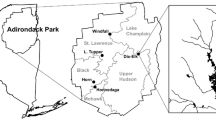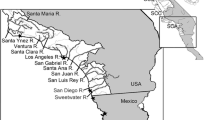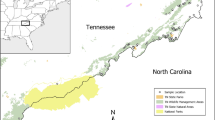Abstract
The release of hatchery-origin fish into streams with endemics can degrade the genetics of wild populations if interbreeding occurs. Starting in the 1800s, brook trout descendent from wild populations in the northeastern United States were stocked from hatcheries into streams across broad areas of North America to create and enhance fishery resources. Across the southeastern United States, many millions of hatchery-origin brook trout have been released into hundreds of streams, but the extent of introgression with native populations is not well resolved despite large phylogeographic distances between these groups. We used three assessment approaches based on 12 microsatellite loci to examine the extent of hatchery introgression in 406 wild brook trout populations in North Carolina. We found high levels of differentiation among most collections (mean F′ST = 0.718), and among most wild collections and hatchery strains (mean F′ST = 0.732). Our assessment of hatchery introgression was consistent across the three metrics, and indicated that most wild populations have not been strongly influenced by supplemental stocking. However, a small proportion of wild populations in North Carolina appear to have been strongly influenced by stocked conspecifics, or in some cases, may have been founded entirely by hatchery lineages. In addition, we found significant differences in the apparent extent of hatchery introgression among major watersheds, with the Savannah River being the most strongly impacted. Conversely, populations in the Pee Dee River watershed showed little to no evidence of hatchery introgression. Our study represents the first large-scale effort to quantify the extent of hatchery introgression across brook trout populations in the southern Appalachians using highly polymorphic microsatellite markers.






Similar content being viewed by others
References
Allendorf FW, Leary RF, Spruell P, Wenburg JK (2001) The problem with hybrids: setting conservation guidelines. Trends Ecol Evol 16:613–622
Angers B, Bernatchez L, Angers A, Desgroseillers L (1995) Specific microsatellite loci for brook charr reveal population subdivision on a microgeographic scale. J Fish Biol 47(Supplement A):177–185
Annett B, Gerlach G, King TL, Whiteley AR (2012) Conservation genetics of remnant coastal brook trout at the southern limit of their distribution: population structure and effects of stocking. Trans Am Fish Soc 141:1399–1410
Barrett RDH, Schluter D (2008) Adaptation from standing genetic variation. Trends Ecol Evol 23:38–44
Bolstad GH, Hindar K, Robertson G, Jonsson B, Sægrov H, Diserud OH, Fiske P, Jensen AJ, Urdal K, Næsje TF, Barlaup BT, Florø-Larsen B, Lo H, Niemalä E, Karlsson S (2017) Gene flow from domesticated escapes alters the life history of wild Atlantic salmon. Ecol Evol 1(0124):1–5
Burley N (1983) The meaning of assortative mating. Ethol Sociobiol 4:191–203
Cavalli-Sforza LL, Edwards AWF (1967) Phylogenetic analysis: models and estimation procedures. Am J Hum Genet 19:233–257
Christie MR, Marine ML, Fox SE, French RA, Blouin MS (2016) A single generation of domestication heritably alters the expression of hundreds of genes. Nat Commun 7:10676
Danzmann RG, Ihssen PE (1995) A phylogeographic survey of brook charr (Salvelinus fontinalis) in Algonquin Park, Ontario based upon mitochondrial DNA variation. Mol Ecol 4:681–697
Do C, Waples RS, Peel D, Macbeth GM, Tillet BJ, Ovenden JR (2014) NeEstimator v2: re-implementation of software for the estimation of contemporary effective population size (Ne) from genetic data. Mol Ecol Resour 14:209–214
Earl DA, vonHoldt BM (2012) STRUCTURE HARVESTER: a website and program for visualizing STRUCTURE output and implementing the Evanno method. Conserv Genet Resour 4:359–361
Einum S, Fleming IA (2001) Implications of stocking: ecological interactions between wild and released salmonids. Nord J Fresh Res 75:56–70
Evanno G, Regnaut S, Goudet J (2005) Detecting the number of clusters of individuals using the software STRUCTURE: a simulation study. Mol Ecol 14:2611–2620
Ferguson MM (1990) The genetic impact of introduced fishes on native species. Can J Zool 68:1053–1057
Ferguson MM, Ihssen PE, Hynes JD (1991) Are cultured stocks of brown trout (Salmo trutta) and rainbow trout (Oncorhyncus mykiss) genetically similar to their source populations? Can J Fish Aquat Sci 48(Supplement 1):118–123
Fleming I, Petersson E (2001) The ability of released, hatchery salmonids to breed and contribute to the natural productivity of wild populations. Nord J Fresh Res 75:71–98
Fraser JM (1989) Establishment of reproducing populations of brook trout after stocking interstrain hybrids in Precambrian Shield lakes. N Am J Fish Manag 9:352–363
Fraser DJ, Weir LK, Bernatchez L, Hansen MM, Taylor EB (2011) Extent and scale of local adaptation in salmonid fishes: review and meta-analysis. Heredity 106:404–420
Galbreath PF, Adams ND, Guffey SZ, Moore CJ, West JL (2001) Persistence of native southern Appalachian Brook Trout populations in the Pigeon River system, North Carolina. N Am J Fish Manag 21:927–934
Glover KA, Solberg MF, McGinnity P, Hindar K, Verspoor E, Coulson MW, Hansen MM, Araki H, Skaala Ø, Svåsand T (2017) Half a century of genetic interaction between farmed and wild Atlantic salmon: status of knowledge and unanswered questions. Fish Fish 18:890–927
Goudet J, Jombart T (2015) hierfstat: estimation and tests of hierarchical F-statistics. R package version 0.04-22. http://CRAN.R-project.org/package=hierfstat. Accessed 12 Feb 2016
Gudmundsson LA, Gudjonsson S, Marteinsdottir G, Scarnecchia DL, Danielsdottir AK, Pampoulie C (2013) Spatio-temporal effects of stray hatchery-reared Atlantic salmon Salmo salar on population genetic structure within a 21 km-long Icelandic river system. Conerv Genet 14:1217–1231
Habera J, Moore S (2005) Managing southern Appalachian brook trout: a position statement. Fisheries 30:10–20
Hall MR, Morgan RP II, Danzmann RG (2002) Mitochondrial DNA analysis of Mid-Atlantic populations of brook trout: the zone of contact for major historical lineages. Trans Am Fish Soc 131:1140–1151
Hayes JP, Guffey SZ, Kriegler FJ, McCracken GF, Parker CR (1996) The genetic diversity of native, stocked, and hybrid populations of brook trout in southern Appalachians. Conserv Biol 10:1403–1412
Hohenlohe PA, Amish SJ, Catchen JM, Allendorf FW, Luikart G (2011) Next-generation RAD sequencing identifies thousands of SNPs for assessing hybridization between rainbow and westslope cutthroat trout. Mol Ecol Resour 11:117–122
Jakobsson M, Rosenberg NA (2007) CLUMPP: a cluster matching and permutation program for dealing with label switching and multimodality in analysis of population structure. Bioinformatics 23:1801–1806
Jensen AJ, Hansen LP, Johnsen BO, Karlsson S (2017) Rapid evolution of genetic and phenotypic divergence in Atlantic salmon following the colonization of two new branches of a watercourse. Genet Sel Evol 49:22
Jombart T (2008) Adegenet: a R package for the multivariate analysis of genetic markers. Bioinformatics 24:1403–1405. https://doi.org/10.1093/bioinformatics/btn129
Jombart T, Devillard S, Balloux F (2010) Discriminant analysis of principal components: a new method for the analysis of genetically structured populations. BMC Genet 11:94
Jones OR, Wang J (2010) COLONY: a program for parentage and sibship inference from multilocus genotype data. Mol Ecol Resour 10:551–555
Jones MW, Clay D, Danzmann RG (1996) Conservation genetics of brook trout (Salvelinus fontinalis): population structuring in Fundy National Park, New Brunswick, and eastern Canada. Can J Fish Aquat Sci 53:2776–2791
King W (1937) Notes on the distribution of native speckled and rainbow trout in the streams of Great Smoky Mountains National Park. J Tennessee Acad Sci 12:351–361
King TL, Lubinski BA, Burnham-Curtis MK, Stott W, Morgan RPII. (2012) Tools for the management and conservation of genetic diversity in brook trout (Salvelinus fontinalis): tri- and tetranucleotide microsatellite markers for the assessment of genetic diversity, phylogeography, and historical demographics. Conserv Genet Resour 4:539–543
Kovach KP, Hand BK, Hohenlohe PA, Cosart TF, Boyer MC, Neville HH, Muhlfield CC, Amish SJ, Carim K, Narum SR, Lowe WH, Allendorf FW, Luikart G (2016) Vive la résistance: genome-wide selection against introduced alleles in invasive hybrid zones. Proc R Soc B. https://doi.org/10.1098/rspb.2016.1380
Kriegler FJ, McCracken GF, Habera JW, Strange RJ (1995) Genetic characterization of Tennessee Brook Trout populations and associated management implications. N Am J Fish Manag 15:804–813
Krueger CC, May B (1991) Ecological and genetic effects of salmonid introductions in North America. Can J Fish Aquat Sci 48(Supplement 1):66–77
Kumar S, Stecher G, Tamura K (2016) MEGA7: molecular evolutionary genetics analysis version 7.0 for bigger datasets. Mol Biol Evol 33:1870–1874
Laikre L, Schwartz MK, Waples R, Ryman N, The GeM Working Group (2010) Compromising genetic diversity in the wild: unmonitored large-scale release of plants and animals. Trends Ecol Evol 25:520–529
Lamaze FC, Sauvage C, Marie A, Garant D, Bernatchez L (2012) Dynamics of introgressive hybridization assessed by SNP population genomics of coding genes in stocked brook charr (Salvelinus fontinalis). Mol Ecol 21:2877–2895
Lamaze FC, Garant D, Bernatchez L (2013) Stocking impacts the expression of candidate genes and physiological condition in introgressed brook charr (Salvelinus fontinalis) populations. Evol Appl 6:393–407
Marie AD, Bernatchez L, Garant D (2010) Loss of genetic integrity correlates with stocking intensity in brook charr (Salvelinus fontinalis). Mol Ecol 19:2025:2037
McCracken GF, Parker CR, Guffey SZ (1993) Genetic differentiation and hybridization between stocked hatchery and native brook trout in Great Smoky Mountains National Park. Trans Am Fish Soc 122:533–542
Meirmans PG, Hedrick PW (2011) Assessing population structure: F ST and related measures. Mol Ecol Resour 11:5–18
Miller LM, Mero SW, Younk JA (2009) The genetic legacy of stocking muskellunge in a northern Minnesota lake. Trans Am Fish Soc 138:602–615
Ostberg CO, Chase DM, Hauser L (2015) Hybridization between Yellowstone cutthroat trout and rainbow trout alters the expression of muscle growth-related genes and their relationships with growth patterns. PLoS ONE 10(10):e0141373
Peakall R, Smouse PE (2006) GENALEX 6: genetic analysis in Excel. Population genetic software for teaching and research. Mol Ecol Notes 6:288–295
Peakall R, Smouse PE (2012) GenAlEx 6.5: genetic analysis in Excel. Population genetic software for teaching and research-an update. Bioinformatics 28:2537–2539
Pritchard JK, Stephens M, Donnelly P (2000) Inference of population structure using multilocus genotype data. Genetics 155:945–959
Quinn TP, Unwin MJ, Kinnison MT (2000) Evolution of temporal isolation in the wild: genetic divergence in timing of migration and breeding by introduced chinook salmon populations. Evolution 54:1372–1385
R Core Team (2015) R: a language and environment for statistical computing. R Foundation for Statistical Computing, Vienna. https://www.R-project.org/
Raymond M, Rousset F (1995) GENEPOP (version 1.2): population genetics software for exact tests and ecumenicism. Heredity 86:248–249
Saitou N, Nei M (1987) The neighbor-joining method: a new method for reconstructing phylogenetic trees. Mol Biol Evol 4:406–425
Santos NP, Fontainhas-Fernandes AA, Faria R, Torres-Castro LF, Anjos MR, Cortes RMV, Alexandrino P (2006) Genetic evidence for limited introgression between wild and stocked individuals in Portuguese brown trout, Salmo trutta populations. Folia Zool 55:433–443
Stauffer J, King TL (2014) Designation of a neotype for brook trout, Salvelinus fontinalis. P Biol Soc Wash 127:557–567
Stoneking M, Wagner DJ, Hildebrand AC (1981) Genetic evidence suggesting subspecific differences between northern and southern populations of brook trout (Salvelinus fontinalis). Copeia 4:810–819
Torterotot J-B, Perrier C, Bergeron NE, Bernatchez L (2014) Influence of forest road culverts and waterfalls on the fine-scale distribution of Brook Trout genetic diversity in a boreal watershed. Trans Am Fish Soc 143:1577–1591
Utter FM (2003) Genetic impacts of fish introductions. In: Hallerman E (ed) Population Genetics: principles and applications for fisheries scientists. American Fisheries Society, Bethesda
Wesner JS, Cornelison JW, Dankmeyer CD, Galbreath PF, Martin TH (2011) Growth, pH tolerance, survival, and diet of introduced northern-strain and native southern-strain Appalachian brook trout. Trans Am Fish Soc 140:37–44
Whitely AR, Coombs JA, Hudy M, Robinson Z, Colton AR, Nislow KH, Letcher BH (2013) Fragmentation and patch size shape genetic structure of brook trout populations. Can J Fish Aquat Sci 70:678–688
Wright K (2015) Corrgram: plot a correlogram. R package version 1.8. http://CRAN.R-project.org/package=corrgram. Accessed Mar 2016
Acknowledgements
Robin Johnson and Mike Eackles provided essential laboratory help to complete the genotyping of these samples. We would also like to thank the North Carolina Wildlife Resources Commission for providing funding to support this research project. We appreciate the contributions of Doug Besler, Jim Borowa, Bob Brown, Bobby Buff, Amanda Bushon, Joe Coleman, Mickey Clemens, Lawrence Dorsey, David Goodfred, Chris Goudreau, Kevin Hining, Kin Hodges, Jimmy Hollifield, Wes Humphries, Thomas Johnson, Kenneth Lingerfelt, Scott Loftis, Joe Mickey, Paul Pittman, Brian Rau, Josh Reams, Zach Scott, Nick Shaver, Win Taylor, Chad Thomas, Powell Wheeler, Chris Wood, Bennett Wynne, and Cal Younce. Use of trade, product, or firm names does not imply endorsement by the U.S. Government.
Author information
Authors and Affiliations
Corresponding author
Electronic supplementary material
Below is the link to the electronic supplementary material.
10592_2017_1037_MOESM1_ESM.xlsx
Sample size, collection information, and hatchery introgression metrics for 406 collections of wild brook trout across North Carolina. Abbreviations are as follows: N total , sample size before redundant fullsibs were removed from the study, N analyzed , sample size after redundant fullsibs were removed from the study, N a , mean number of alleles per loci, H o , observed heterozygosity, uH e – unbiased expected heterozygosity, P a – number of private alleles, %P – percentage of loci that were polymorphic, HWE – reported as the proportion of loci that deviate significantly (using a Bonferroni corrected critical P-value) from conformance to Hardy-Weinberg equilibrium expectations (0.00 corresponds to no observed deviations from Hardy-Weinberg equilibrium); LD – proportion of loci pairs that exhibit significant (using a Bonferroni corrected critical P-value) linkage disequilibrium (0.00 corresponds to no observations of linkage-disequilibrium), N e – effective population size, D C - hatchery introgression metric based on chord distance, STRUCTURE – hatchery introgression metric based on STRUCTURE membership coefficients, and DAPC – hatchery introgression metric based on discriminant analysis of principle components (XLSX 76 KB)
Rights and permissions
About this article
Cite this article
Kazyak, D.C., Rash, J., Lubinski, B.A. et al. Assessing the impact of stocking northern-origin hatchery brook trout on the genetics of wild populations in North Carolina. Conserv Genet 19, 207–219 (2018). https://doi.org/10.1007/s10592-017-1037-4
Received:
Accepted:
Published:
Issue Date:
DOI: https://doi.org/10.1007/s10592-017-1037-4




